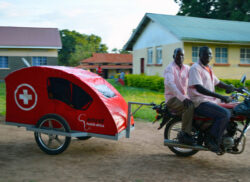
As then Health Cabinet Secretary Sicily Kariuki noted at the 6th Diaspora Homecoming Convention, 2019, one of the lessons the ministry has learned from the UHC pilot programme is that to succeed, there must be adoption of technology, specifically mobile technology.
But the technology or innovation does not have to be grand.
Here is an illustrative story:
Where bodabodas work like ambulances, ferrying expectant mothers to hospitals
The slopes of Mt Elgon look disarmingly cool and laidback. Residents move around unhurried, boda bodas revving and raising dust as they pick and drop customers. Cows moo. A dog barks, and a boy throws a stone at it.
Here in Kaptanai, a quiet village in Sirisia, about 50 kilometres from Bungoma town, the main mode of transport is the motorcycle, commonly known as the boda boda.
Like anywhere else in Kenya, and indeed around East Africa, the boda boda riders are loved and loathed in equal measure. Most flout traffic rules and considered a danger to other road users. A majority of these riders are school dropouts lured to the sector by the promise of quick money. For a small fee, they are trained how to ride the motorcycles by other riders who never went to a driving school. Others are used as getaway riders by criminals, with some actively involved in robberies and other crimes.
But something curious happened here in Sirisia Sub-County in 2015. An NGO that focuses on maternal health was overwhelmed by the number of mothers who lost their lives and/or newborn babies during delivery. According to the United Nations Population Fund (UNFPA) in a 2014 report, Bungoma County was ranked eighth out of 15 counties in Kenya with high rates of maternal deaths. In fact, the Kenya Demographic and Health Survey 2014 indicated that only 46 percent of women delivered in health facilities, and that only 40 percent were assisted to deliver by skilled healthcare providers. The rest gave birth at home, most times assisted by untrained (and now outlawed) traditional birth attendants.
The NGO realised that most of the residents of Bungoma County lived far from health centres. Others resided in remote, hilly terrains with thick bushes where no car or ambulance could access. This meant that in case of an emergency occasioned by labour or any pregnancy-related condition or complication, especially at night, expectant mothers could easily lose their lives if not rushed to a health centre in good time.
That is how the idea of using motorcycles to ferry the women to clinics for ante-natal care and delivery was born. Doctors recommend four ante-natal clinic visits before delivery. However, most women from rural areas like Sirisia just make one visit during the period of their pregnancy. This is dangerous because it is during the ante-natal clinics that doctors can identify risk factors earlier, such as high blood pressure and infections like HIV/Aid. Identifying these risk factors earlier enables proper care for the expectant women until safe delivery.
The NGO, Maternal and Newborn Initiative (MANI), believed that safety was the most important aspect of the boda boda ambulance initiative. They therefore roped in relevant authorities incuding the Traffic Police Department, who trained the riders on road safety. For the first time, the selected riders were issued with motorcycle licences after successfully finishing the instructional training. They were also given protective gear.
“In healthcare,” said Gladys Ngeno of MANI, “there is the demand and supply side. We needed to create demand for facility-based maternal care through innovation.”
But this was just one aspect of the strategy. How would mothers know which boda boda rider to trust? Enter Community Health Volunteers (CHVs). MANI also trained the volunteers on the basics of maternal health. One of their roles was to go through the villages identifying pregnant mothers. The CHVs would assess the expectant mothers’ households and those who were deemed needy would be given a voucher to present at the dispensary during delivery.
The CHVs, armed with mobile phones that used USSD code, hence no need to connect to the internet or buy airtime, then teamed up with trained boda boda riders and were on 24/7 call in case an expectant mother had an emergency.
The boda bodas became so adept at transferring mothers to hospital that they were soon nicknamed ‘boda boda ambulances.’ When not taking the mothers to hospital, they would carry on with their daily work of ferrying passengers. MANI paid them for each trip to the hospital, hence their income increased.
In an earlier interview, the Kaptanai Dispensary Clinical Officer in Charge John Wabomba, said that before 2015 when the boda boda project started, they had about five deliveries at the centre. By 2018, that number had increased to an average of 25 in a month.
MANI corroborated this, noting that in two years since the beginning of the programme, they had seen a 20 percent increase in health facility delivery.
Save the Children Fund also had a similar programme, where they paid boda boda riders KSh500 for any referral they made to a health facility.
The County Government of Bungoma took up the initiative, where, for instance at the Kopsiro facility in Mt Elgon, there are about 70 CHVs who refer mothers for ante-natal care, deliveries and child welfare clinics. They get a KSh2,000-stipend per month.
As highlighted in the Primary Care chapter, the CHVs play an important role in preventing illnesses in their communities. For instance, in Bungoma, they have been empowered to test for malaria, which is prevalent in the area. They were equipped with test kits, the Malaria Test Diagnostic, and medication for patients who test positive for the disease. This helps in decongesting health facilities, while saving the community from treks to health centres.
This is just but one of the tested and proven ways of taking healthcare to the community, through the primary healthcare model.
